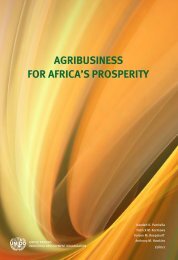Collection of Case Studies 2. - Seas of Change Initiative
Collection of Case Studies 2. - Seas of Change Initiative
Collection of Case Studies 2. - Seas of Change Initiative
You also want an ePaper? Increase the reach of your titles
YUMPU automatically turns print PDFs into web optimized ePapers that Google loves.
commercialise rice production through a policy dialogue. This led for instance to the streamlining <strong>of</strong> tradeprocedures, reduction <strong>of</strong> import taxes on agricultural inputs, and the retraction <strong>of</strong> trade bans.Overall the rice value chain is far more integrated, the actors collaborate more closely and are better able to planand make informed decisions. Farmers have greater confidence in marketing their crop and are more heavilycommitted to it as a commercial crop. The millers have become proactive in seeking new markets. Through itssupport for policy dialogue, EMRIP has seen specific outcomes with a streamlining in trade procedures; reductionin import taxes on agricultural inputs; and retraction <strong>of</strong> trade bans. This process has opened the door to theinclusion <strong>of</strong> millers in constructive dialogue with provincial authorities which should continue to inform decisions atthis level.These results are exceptional and <strong>of</strong> great significance for development strategies related to rice productionnationally. The EMRIP project is essentially an Inclusive Business model and succeeded in gaining substantial yieldincreases both at a farm and macro level.A mechanism that could scale-out this Inclusive Business model for rice production is the establishment andstrengthening <strong>of</strong> miller groups. This provides the opportunity for core members experienced in the mechanism tointroduce support to farmers as ‘standard practice’ to new mills joining a group. The replication <strong>of</strong> the EMRIPapproach by the millers not participating in the project has already started in some <strong>of</strong> the target provincesthrough miller groups. Several actors are interested in scaling up the programme further; for instance SNVreceives funding from the Rabobank Foundation to strengthen the farmer groups and in partnership with Helvetasother options to upscale the programme are being explored.Annex 01Gross Income per hectare before and after miller supportItems Unit Quantity Rate in Total amount in EurosEurosGross income before supportTotal value <strong>of</strong> harvest – mixed grad Kg 2000 0.2 400Variable costsLocal seed Kg 60 0.2 12Fertiliser Bag 1 21 21Total variable cost 33Gross margin before support 367Gross income after supportTotal value <strong>of</strong> harvest – single variety with Kg 2800 0.24 672higher yield with premium priceVariable costsFresh HYV seed Kg 60 0.48 29Fertiliser Bag 2 21 42Total variable costs 81Gross margin after support 59122







